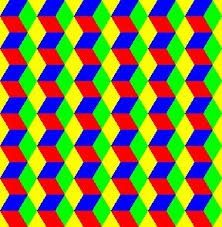To me the obvious answer to this question was no. When I look back to my time learning maths in school my memories mainly consist of textbooks pages, worksheets, and more textbook pages. For most of us this was, and still is our experience of maths within the classroom.
According to the ‘Trends in International Mathematics and Science Study’ (IEA, 2008), 72% of Scotland’s P5 pupils were taught using a textbook as the primary resource. Also, the most common type of maths activity given in classrooms throughout Scotland is based on pupils “working quietly own your own” and from a textbook. 50% of the P5 pupils surveyed said that during most lessons they are told to work silently and individually, and 55% of children in P3 agreed (Scottish government, 2009). These figures very clearly show there is a lack of creativity in the maths lessons being taught in our classrooms.
In my experience of both being the learner and during my time on placement last year, when a lesson is not engaging, or you are not interested, it makes it very difficult to concentrate to what is being taught. If a teacher is simply standing at the front of the class explaining a new concept, the moment you lose concentration or engagement in what is being said, you then immediately shut off completely. By shutting off completely this is very likely to result in gaps in knowledge and understanding, this then leads to a cycle of losing increasingly more engagement and becoming gradually more and more lost or confused. Over time this lack of engagement and therefore lack of understanding can lead to anxieties and hatred towards the subject. I feel this can is one of the main causes of maths anxieties, which I discussed in my previous blog post.
Lampart(2009) identifies the main believes towards mathematics. Some of these include: the idea that maths problems only have one right answer, that there is only one way to solve a problem, and that most students do not expect to understand the mathematics but simply need memorise it and apply it to each question. The idea that an answer to a maths problem is either right or wrong and that you can only solve it in one way, I feel is one of the main reasons why the subject can appear to lack any creativity or room for imagination.
So how can we make maths creative and fun?
Maths and art
In one of our recent workshops with Eddie we were looking at how maths can be explored creatively, specifically through art. We discussed in this session various ways throughout history that artists have used mathematical concepts such as symmetry, tessellation and proportion to create works of art. For example, the importance of renaissance painters working out the proportions of the persons facial features in relation to face and body size by calculating mathematical ratios, the most famous painting of all time the Mona Lisa was created using these mathematical techniques.
During this input we also focused on the Islamic art technique of tessellations, and how these can be used to creatively teach geometry within a classroom. A Tessellation is a pattern of repeated shapes that fit perfectly together with no gaps spaces or overlaps. Regular tessellations are made up of only one regular shape repeated, whereas semi-regular tessellations are made up of two or more regular shapes to create a repeating pattern. Regular shapes that tessellate include: squares, hexagons and equilateral triangles. Regular shapes are those which have all their sides the same length and all the internal angles the same size, the reason these tesselate is that when all vertices meet they create a 360 degree angle.


In this input we had the chance to see how this could be done within a classroom and made our own tessellations. We were given sheets with various shapes on and were able to choose which shapes we would like our piece to consist of, we then cut these out and stuck them onto a coloured piece of card making sure there was no gaps, spaces or overlaps between the shapes and the pattern was able to be continuously repeated. We were then able to pain our shapes and make them look as colourful and creative as we wanted. I really enjoyed this activity and found it strangely relaxing, in no way did it feel like we were doing a maths task. I feel like this would be a great way in a classroom to introduce or develop geometry, as for those who dread the idea of a maths lesson or opening up a textbook this can make learning maths much more enjoyable and less terrifying. It also provides children with the opportunity to see how maths surrounds us, rather than the idea that you will never use it again once you leave school.
This workshop really opened my eyes to how maths can be made creative, and the impact this can have on the engagement of the learners, because I actually found myself enjoying a maths activity which I honesty i don’t think I have said many times in my life. Looking forward to my further development towards becoming a teacher, I think this will effect the way i look at and aim to teach mathematics in the coming years. I must continue to look for creative applications and ways to incorporate maths into the classroom that will engage and excite learners, and prove that maths really isn’t always textbooks and worksheets, it surrounds us in everything we do.
References
IEA (2008) Trends in Mathematics and Science Survey 2007. Lynch School of Education, Boston College: International Association for the Evaluation of Educational Achievement.
Lampert, M. (1990) ‘When the problem is not the problem and the solution is not the answer: Mathematical knowing and teaching’, American Research Journal, 27(1), pp.29-63
Scottish Government (2009) 2008 Scottish Survey of Achievement: Mathematics and Core Skills. Available online at: http://www.scotland.gov.uk/Publications/2009/04/02133043/0 [Accessed October 2017].

